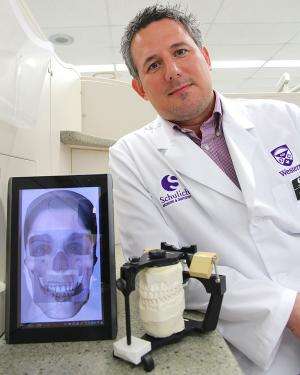Professor's app breaks the mould to create a new one

Les Kalman lives outside the box. And in your mouth.
"I've always been the guy where, if we're doing clinical dentistry and there is repetitive work, something we're doing over and over, I try and look to change it up without losing the needed accuracy," said the Schulich School of Medicine & Dentistry professor. "Dentistry is pretty market driven and a lot of what I'm doing is trying to make clinical dentistry better for the patient and the dentist."
His latest idea, the Virtual Facebow app, is a digital companion for the diagnosis and treatment-planning phase of dentistry. Available in the Android market, the app also acts as an educational guide for dental students or patients undergoing treatment.
"When we see a patient for the first time, we need up-front data," Kalman said. "We're going to need models of your teeth. If you're just in for a check-up or cleaning there's no real need. But if you are doing a denture, a bridge or an implant, that's when we do the mould."
A dental mould – or impression – is an imprint of your teeth used for everything from diagnosis and treatment planning to the creation of custom trays, dentures, crowns or other prostheses and orthodontics. A proper mould will capture the teeth and surround structures of the oral cavity; it is the map to your mouth.
But moulds are not 100 per cent accurate – one in three needs to be remade.
Kalman's app replaces the physical process with a digital one – creating, in his words, a more accurate reading for the patient and the dentist.
"Let's go digital where we can have safeguards built in," he said. "You can email the whole series to the lab, which would be great for them to verify what a dentist is requesting. We always want the best for the patients. This improves time, accuracy and reduces remakes by 5-10 per cent. Think of the money saved."
Kalman recently finished a clinical study on his new app this summer, with the findings to be presented next month at the American Academy of Implant Dentistry annual meeting in Phoenix. He also spoke during a webinar with the International Congress of Oral Implantologists, and the app will be exhibited this November at the Greater New York Dental Meeting in New York City.
The app has also been earmarked as a finalist in the Intel App Innovation contest.
While it may not mean the complete elimination of moulds, Kalman said allowing dentists to do everything from establishing the lower jaw cast to the upper with an accurate bite, creating an aesthetic tooth guide prior to treatment and email entire data sets in common JPEG or PDF formats – all with a simple touch of their finger – is a huge step forward.
"The analogy I like to use is I think this did for diagnosis and treatment what bristles did for the toothbrush," laughed Kalman. "It's about keeping it simple. It can be a wonderful learning tool for students and, if we can win the patient over, it's a great tool to teach them and reinforce their comfort level."




















